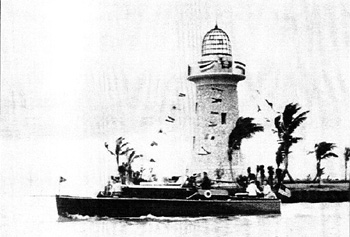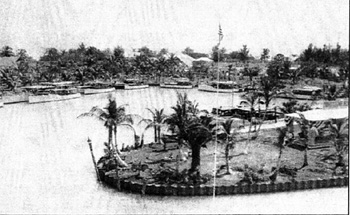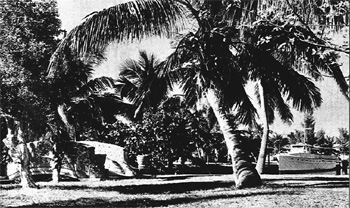
Park’s life began as monument in 1968
HOMESTEAD, Fla.—Biscayne National Park was established by the United States Congress in 1968.
According to historian Jennifer Brown Leynes of the Cultural Resources Stewardship, the park was created “to preserve and protect the tropical setting, vegetation and animal life of Biscayne Bay and the Upper Florida Keys.”
 |
| A yacht passes the lighthouse at Boca Chita Key in 1938 (Photo courtesy of National Park Service). |
“The idea of a marine national park was pretty foreign at the time,” said Biscayne National Park Ranger Gary Bremen.
The new park was called the Biscayne National Monument.
In the late 1950s, a plan was developed which would have turned Biscayne Bay into a jetport.
Then in 1961, 13 landowners from the South Florida area unanimously approved a plan to create the City of Islandia in Biscayne Bay. The plan called for a bridge to connect all of the Keys in Biscayne Bay. A year later, plans were made to create a major industrial seaport, called Seadade.
A small group of protestors envisioned a different future for Biscayne Bay, a national park. The group was called the Safe Progress Association. Wealthy business people and ordinary citizens alike vocalized their efforts to preserve Biscayne Bay and turn it into a national park.
Herbert W. Hoover, the vacuum cleaner magnate, spent his own money to bring legislators from Washington D.C. to Biscayne Bay to look at the park. Hoover took these legislators on blimp rides over Biscayne Bay to convince them that the area should be turned into a national park.
Local politician Hardy Matheson, who was running for county commissioner, based his entire campaign on the establishment of a national park at Biscayne Bay.
 |
| Yachts in the harbor at Boca Chita Key in 1938 (Photo courtesy of National Park Service). |
Despite the heavy opposition, landowners in the city of Islandia built a seven mile long highway down the middle of Elliott Key.
This highway was dubbed the “Spite Highway” because it was built in spite of the large opposition to any development in Biscayne Bay.
In 1968, Dante Fascell, a long-time member of the U.S. House of Representatives, created Biscayne National Monument in order to protect “a rare combination of terrestrial, marine and amphibious life in a tropical setting of great natural beauty.”
On Oct. 18, 1968, Biscayne National Monument officially became a national park as President Lyndon B. Johnson signed the bill into law.
In 1970, a local developer tried to turn Porgy Key, which was owned by Lancelot Jones, whose family had lived on and owned the Key since the late 1890s. The developer’s plan was to turn Porgy Key and the surrounding islands into another version of Miami Beach.
 |
| The bridge on Boca Chita Key in 1938 (Photo courtesy of the National Park Service). |
Jones turned down the developer’s offer, and instead sold his property to the Park Service for $1.2 million.
This turned Porgy Key into part of Biscayne National Monument. The park was renamed Biscayne National Park in 1980.
“At this time, the park was expanded to the north of Sands Key to include Boca Chita Key and the five Ragged Keys,” said Bremen.
Biscayne National Park is made up of 180,000 acres. The park is unique in the fact that 95 percent of the park is water. Forty-two keys make up the five percent of the national park that is comprised of land. The park includes 4,825 acres of mostly undeveloped red mangrove forest.

Comments are Closed